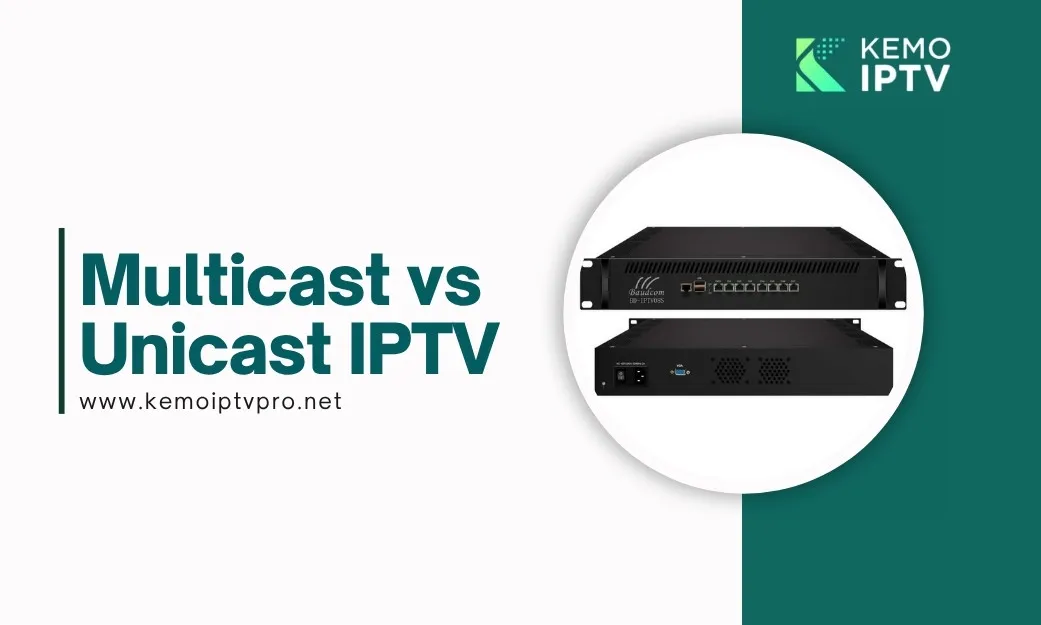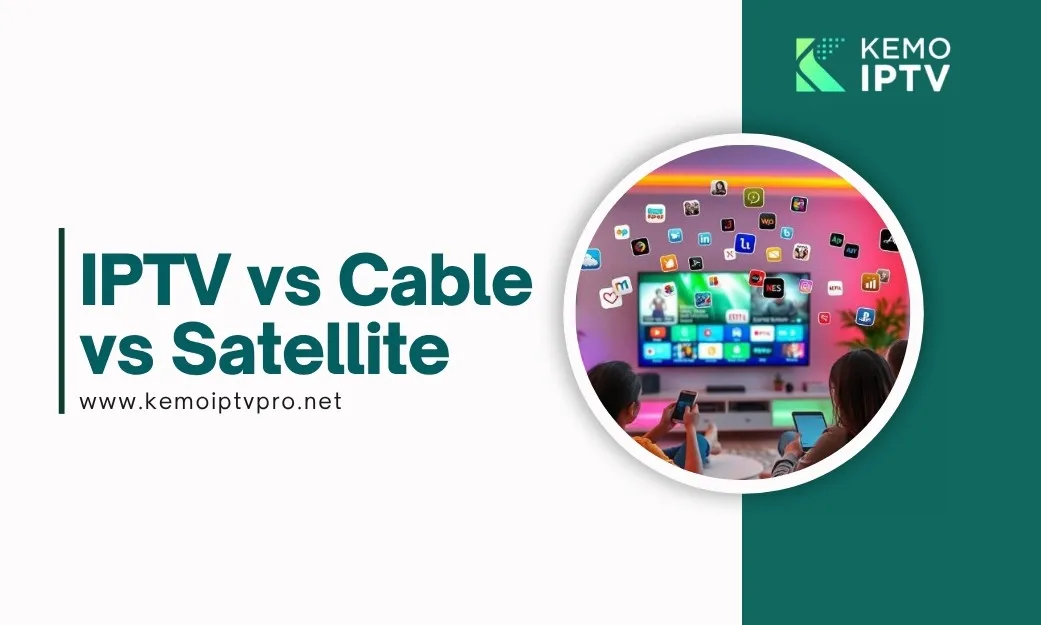This comprehensive glossary demystifies the technical terminology of Internet Protocol Television (IPTV), which reached 250 million subscribers worldwide by 2025. Understanding these terms empowers consumers to make informed decisions about services and helps professionals navigate the evolving landscape of internet-based television delivery.
A
Adaptive Bitrate Streaming (ABR)
A streaming technology that automatically adjusts video quality in real-time based on the viewer’s available bandwidth. The video is encoded at multiple bitrates and resolutions, allowing the player to seamlessly switch between versions to maintain continuous playback without buffering. For example, if your connection speed drops, the stream automatically shifts from HD to SD temporarily rather than pausing to buffer.
AVOD (Advertising-Based Video on Demand)
A monetization model where content is offered free to viewers, with revenue generated through advertisement breaks. Viewers don’t pay subscription fees but watch periodic ads during their content. Examples include free streaming services like Tubi or the ad-supported tier of Peacock.
B
Bitrate
The amount of data used to encode one second of video or audio, typically measured in megabits per second (Mbps). Higher bitrates generally result in better quality but require more network bandwidth. Standard Definition typically requires 3-5 Mbps, HD needs 10-20 Mbps, and 4K/UHD demands 25-50 Mbps.
Buffering
The process where a receiving device pre-loads segments of video stream into memory before and during playback to ensure smooth viewing despite network fluctuations. When the buffer empties faster than it fills (due to insufficient bandwidth), viewers experience the frustrating “buffering” pause with a spinning loader icon.
C
CAS (Conditional Access System)
A hardware-based content protection system traditionally used in broadcast television to control subscriber access. CAS typically uses smart cards or similar physical authentication methods to ensure only authorized, paying subscribers can decrypt and view protected content.
Catch-Up TV
An IPTV feature allowing viewers to watch recently broadcast television programs after their original air time. Content typically remains available for a limited period (commonly 7 days) after the initial broadcast, bridging the gap between live TV and on-demand viewing.
CDN (Content Delivery Network)
A geographically distributed network of proxy servers that cache content closer to end-users. CDNs reduce latency and improve streaming performance by delivering content from the nearest server rather than the origin server. This infrastructure is crucial for maintaining buffer-free viewing experiences across large subscriber bases.
D
Digital Rights Management (DRM)
Software-based content protection systems that prevent piracy and unauthorized access to IPTV streams. DRM encrypts video streams so only authorized devices with proper decryption keys can play content. Common DRM technologies include Widevine, PlayReady, and Verimatrix.
E
EPG (Electronic Program Guide)
An interactive, on-screen menu displaying scheduling information for current and upcoming programs on linear TV channels. Unlike traditional printed guides, IPTV EPGs allow users to click directly on programs to watch, record, or set reminders, making large channel lineups easily navigable.
H
Headend
The central facility where television content originates in an IPTV system. The headend houses equipment that receives content from various sources (satellite feeds, terrestrial broadcasts), encodes or transcodes it into appropriate digital formats, encrypts it for security, and packages it into IP streams for distribution.
HEVC (H.265/High Efficiency Video Coding)
An advanced video compression standard that can deliver the same visual quality as H.264 while using approximately 50% less bandwidth. This codec enables efficient streaming of HD and 4K content over limited bandwidth connections.
Hybrid IPTV
A service model combining traditional broadcast methods (cable, satellite, or terrestrial) for live channels with IP-based delivery for on-demand content and interactive services, all managed through a single interface.
I
IGMP (Internet Group Management Protocol)
The control protocol managing membership in multicast groups. When viewers change channels, their set-top box sends IGMP “join” messages to subscribe to new channel streams and “leave” messages for previous channels. This protocol fundamentally controls channel changing in IPTV environments.
IP (Internet Protocol)
The foundational communication protocol defining rules and formats for sending data packets across networks. IP serves as the universal “language” enabling all IPTV ecosystem components to communicate.
IPTV (Internet Protocol Television)
A system delivering television services using Internet Protocol over a managed, private network controlled by the service provider (typically a telecommunications company). Unlike OTT services, IPTV operates on closed networks with guaranteed Quality of Service, enabling consistent, high-quality streaming with minimal buffering.
J
Jitter
Variation in the arrival time of data packets at their destination. High jitter causes packets to arrive at inconsistent intervals, potentially disrupting video stream decoding and causing visual artifacts. IPTV systems use playout buffers to absorb jitter and ensure steady playback.
L
Latency
The time delay between an event occurring and its display on screen. In IPTV, this includes “zapping delay” (time for a new channel to appear after selection) and the gap between real-world events and their on-screen appearance. Low latency is critical for live sports and interactive broadcasts.
Live IPTV
Real-time streaming of television channels over IP networks, replicating traditional broadcast TV in digital format. Live IPTV typically uses multicast technology for efficient bandwidth usage and supports interactive features like pause and rewind that aren’t possible with conventional broadcasting.
M
M3U Playlist
A text-based file (with .m3u or .m3u8 extension) containing URLs and metadata for IPTV streams. The playlist doesn’t contain video data itself but points IPTV players to stream sources for each channel, making it easy to load and share channel lineups.
Middleware
The software platform connecting all IPTV service components. Middleware manages user authentication, subscription packages, billing, content distribution, user interfaces, and DRM enforcement. It essentially serves as the “brain” of the IPTV system, transforming raw video streams into a commercial service.
Multicast
A one-to-many network transmission method where a single stream serves multiple receivers simultaneously. Essential for live TV delivery, multicast dramatically reduces bandwidth requirements compared to sending individual streams to each viewer. Network trials show multicast can reduce core network traffic by up to 48% during popular events.
N
Near Video on Demand (NVOD)
A pay-per-view model for high-demand content where the same program broadcasts on multiple channels with staggered start times (e.g., every 15-30 minutes), allowing viewers to begin watching at convenient intervals.
Network Personal Video Recorder (nPVR)
Also called Cloud DVR, this service stores recorded television programs on the provider’s network servers rather than local devices. Users can schedule and access recordings from any authorized device with internet connectivity.
O
OTT (Over-the-Top)
Media services delivered over the public internet without a dedicated network operator managing the transmission. Services like Netflix, Hulu, and YouTube TV are OTT platforms. Unlike IPTV, OTT quality depends on public internet conditions and operates on a “best-effort” basis without guaranteed service quality.
P
Packet Loss
Occurs when IP packets containing video or audio data fail to reach their destination due to network congestion or errors. Packet loss causes visual impairments including pixelation, freezing, or complete picture loss. Managed IPTV networks specifically minimize packet loss through quality control.
Q
QoE (Quality of Experience)
A subjective measure of customer satisfaction with the overall IPTV service. QoE encompasses technical factors like picture quality and buffering, plus user experience elements like interface ease-of-use, content availability, and feature responsiveness.
QoS (Quality of Service)
Technologies and processes used by network operators to guarantee performance levels for specific applications. In IPTV, QoS ensures reliable video delivery through traffic prioritization and control of packet loss and jitter within managed networks.
R
RTP (Real-time Transport Protocol)
Protocol for delivering audio and video data over IP networks. Running on UDP, RTP adds timestamps for synchronizing audio/video and sequence numbers for detecting packet loss and reordering out-of-sequence packets.
RTSP (Real-Time Streaming Protocol)
A network control protocol for commanding streaming media servers. RTSP provides VCR-like controls (play, pause, rewind, stop) essential for VOD services.
S
Set-Top Box (STB)
A dedicated hardware device connecting televisions to IP networks for IPTV reception. STBs decode encrypted IP streams, process compressed video, and output standard video signals (like HDMI) for TV display. Modern “boxless” IPTV alternatives include apps on Smart TVs and streaming devices.
SVOD (Subscription Video on Demand)
A monetization model where users pay recurring fees (typically monthly) for unlimited access to a content library. Examples include Netflix subscriptions or premium tiers of IPTV services.
T
TCP (Transmission Control Protocol)
A reliable, connection-oriented transport protocol guaranteeing packet delivery in correct order. Used for critical control signals and some VOD applications where data integrity is paramount.
Time-Shifted TV
Functionality allowing viewers to pause, rewind, or fast-forward live television broadcasts. The system creates a real-time buffer of the live stream, enabling viewers to control playback timing without missing content.
TVOD (Transactional Video on Demand)
A pay-per-title model where users purchase or rent individual content pieces. Includes digital movie rentals (e.g., 48-hour access) or one-time pay-per-view events like boxing matches or concerts.
U
UDP (User Datagram Protocol)
A fast, connectionless transport protocol that sends packets without guaranteeing delivery or order. Its low overhead makes it ideal for real-time live streaming where speed matters more than recovering occasional lost packets.
Unicast
One-to-one data transmission where servers send unique, separate streams to each individual client. Used for VOD and on-demand services since each user’s content request is unique. While perfect for personalized content, unicast is inefficient for live events compared to multicast.
V
Video Codec
Algorithms for compressing and decompressing digital video. Modern codecs like H.264 (AVC) and H.265 (HEVC) enable high-quality streaming over limited bandwidth by reducing file sizes while maintaining visual quality.
VOD (Video on Demand)
A core IPTV feature allowing users to select and watch content from digital libraries at their convenience, independent of broadcast schedules. VOD transforms television from a scheduled medium to an on-demand experience.
Conclusion
This glossary covers the essential terminology needed to understand IPTV technology and services. As the industry continues evolving with innovations like 5G networks, AI-powered recommendations, and cloud infrastructure, new terms will emerge. However, these foundational concepts provide the knowledge base necessary to navigate the future of television delivery, whether through next-generation IPTV, OTT applications, or emerging hybrid models that blur the lines between traditional and internet-based broadcasting.




